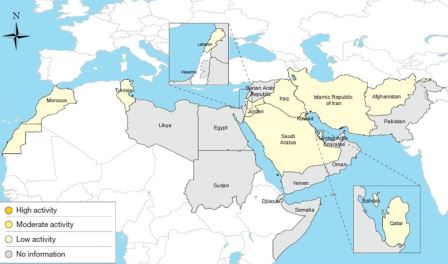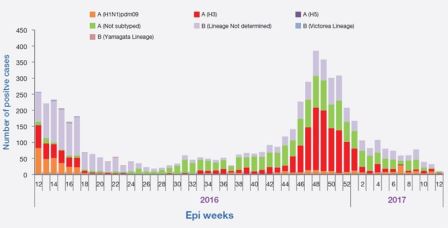In the WHO Eastern Mediterranean Region, influenza activity for the month of March 2017 remained low in countries of the Region reporting data to FluNet and EMFLU namely, Afghanistan, Bahrain, Islamic Republic of Iran, Iraq, Jordan, Kuwait, Lebanon, Morocco, Qatar, Saudi Arabia, and Tunisia (Fig. 1). All seasonal influenza subtypes were detected in the Region.

Disclaimer: The presentation of material on the maps contained herein does not imply the expression of any opinion whatsoever on the part of the World Health Organization concerning the legal status of any country, territory, city or areas or its authorities of its frontiers or boundaries. Dotted lines on maps represent approximate border areas for which there may not yet be full agreement.
Fig. 1. Situation of influenza circulation in Eastern Mediterranean Region, March 2017
Influenza activity by sub-type
- In March 2017, no new cases of influenza A/H5N1 were reported in Egypt.
- In northern Africa influenza transmission zone, Morocco and Tunisia detected influenza B and Influenza A/H3 viruses. In western Asia influenza transmission zone, Bahrain and Jordan reported circulation of influenza A/H3 virus, while Qatar reported all seasonal influenza subtypes. In southern Asia transmission zone, the Islamic Republic of Iran reported Influenza A/H3 virus (Fig. 2).

Fig. 2. Weekly positive cases of influenza by sub-type, March 2016–March 2017
Circulating influenza viruses by subtype
- During March 2017, national influenza centres in the Region and influenza laboratories tested a total of 1789 specimens for influenza viruses of which 139 (7.8%) tested positive. Among tested influenza viruses 87 (63%) were influenza A viruses and 52 (37%) were influenza B viruses (Fig. 3).
- Out of 87 influenza A viruses, 44 (51%) influenza A viruses were subtyped as follows: 29 (66%) were influenza A/H1N1pdm09 viruses and 15 (34%) were influenza A/ H3 viruses.









